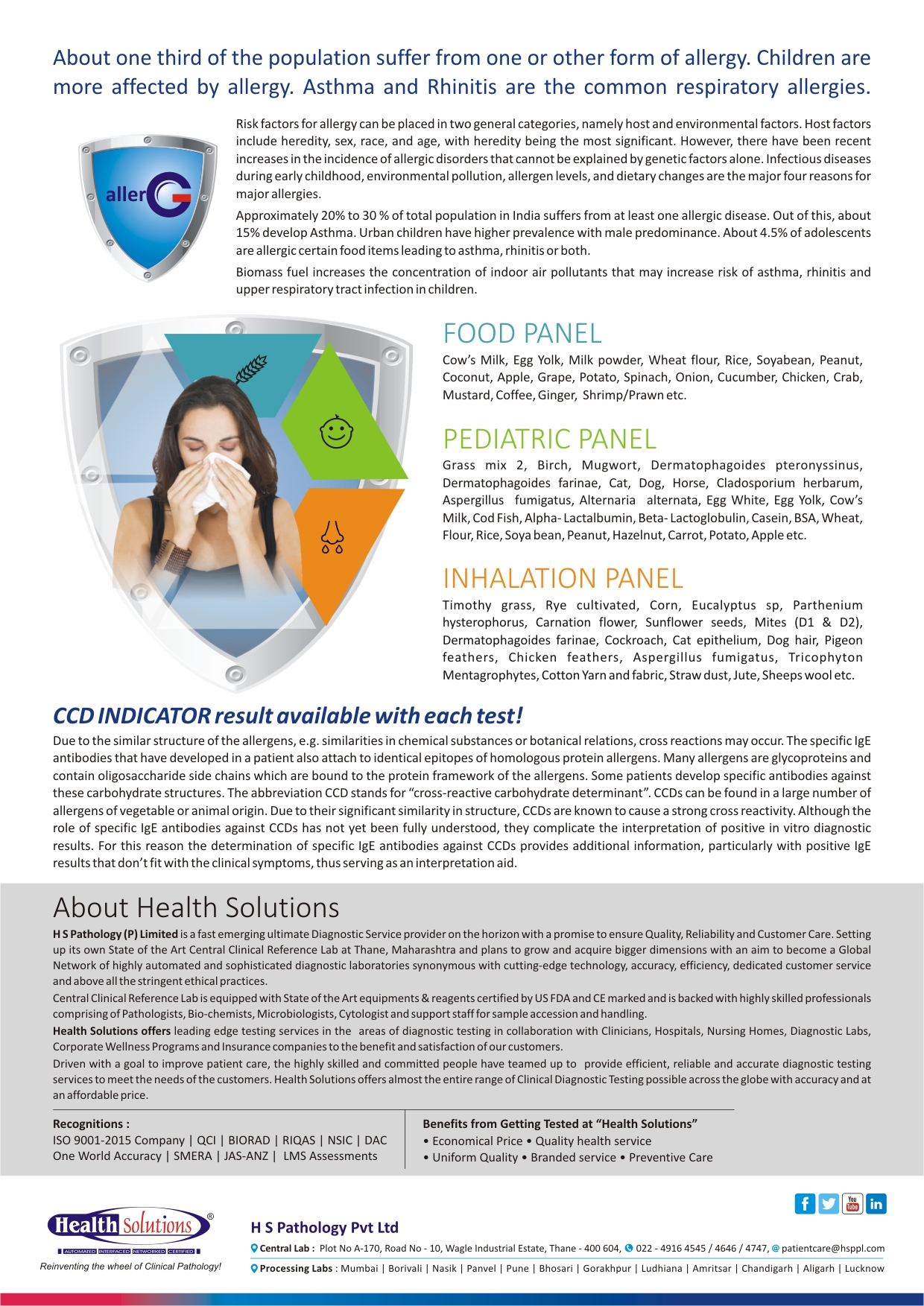-
0 tests / Rs. 0.00 Cart
Cart

 Cart
Cart 
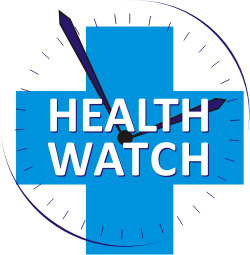
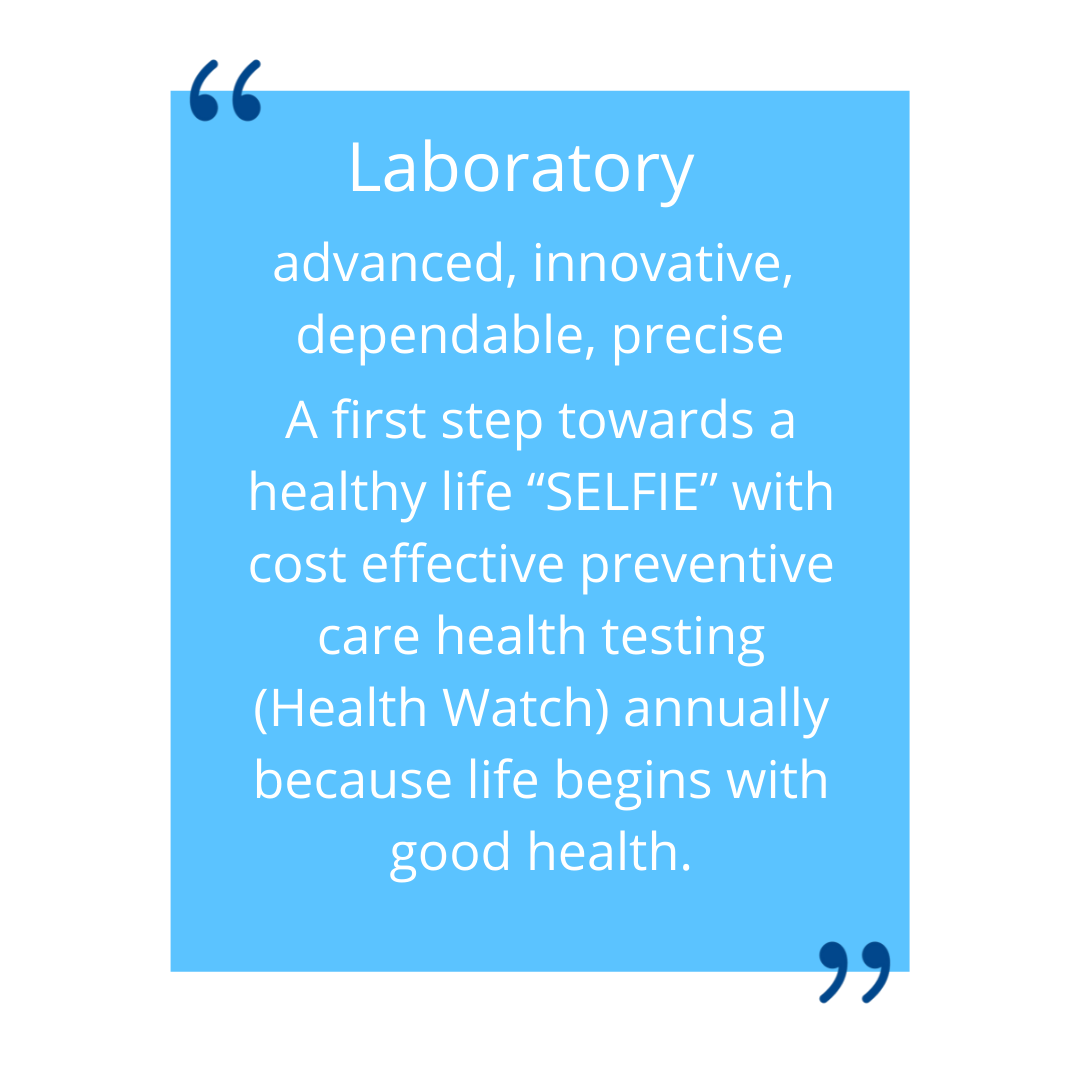
Preventive health care refers to actions and lifestyle choices that serve to prevent future health complications or reduce the likelihood of serious illness and disease. This can include daily actions such as regular washing of hands and avoiding contact with people showing obvious signs of communicable illness, or larger decisions such as eating healthily, finding time for exercise, and having regular screenings and checkups for common or likely illnesses. Preventive health care may initially seem like it requires a great deal of time, especially for someone who changes his or her lifestyle in an effort to remain healthy. It can, however, save a great deal of te and money if it effectively prevents illness or disease and reduces the need for expensive treatment.
While preventive health care may take many different forms, they all have the same basic goal: to prevent illness and disease before they occur, rather than only treating a problem after it is found. Preventive health care includes four basic means of preventing or treating diseases and other illnesses. These are avoiding the development of a disease or illness, promoting early detection of diseases, reducing the effects of an already established illness, and avoiding the potential negative impact of unnecessary interactions with the health care system.
Some disorders like heart disease may result in sudden death without any previous warning signs. Prevention, in such cases, is not only better than cure but is often the only option for a healthy life. Modern lifestyles don’t leave people with quality time for healthy routines. It then becomes necessary that periodic health checkups be done for early detection of risk factors and diseases. Diabetes, Obesity, Hypertension, Stress, High Cholesterol, Heart Diseases… Most of the diseases are “silent”, We often do not have any early symptoms.
Hence regular screening tests are the only way for early detection. All these diseases are quite debilitating. They seriously impair normal life and if left untreated, lead to complications and may even cause death. Fortunately, these diseases can be easily prevented and even fully cured if detected early. Some of these diseases can be ‘managed’ so that you can lead a near normal life. All that you need to do is to make slight modifications in your lifestyle, eat regularly and responsibly, exercise, avoid stress, and sleep well. Regular health check – ups coupled with these lifestyle changes, can go a long way in the prevention, early detection and cure of these diseases.
Health Solutions is also looking to partner with
hospitals to help them manage
their
labs more efficiently and with better profitability.
The company’s business plan incorporates the idea of establishing network of Business Associates
across the country. The Lab
is supported by over 10000 collection points spread in different states and further expansion
with
respect
to appointment of collection points is in progress.
In Preventive Care Profile, we have designed a set of comprehensive full body health checkup profile. The profile include all the necessary diagnostic tests for males and females, all conducted on the world's most advanced equipment by experienced doctors and other healthcare professionals.




Diabetes is a serious life-long health condition that occurs when the amount of glucose (sugar) in the blood is too high because the body can’t use it properly. If left untreated, high blood glucose levels can cause serious health complications.
There are two main types of diabetes: Type 1 and Type 2. They’re different conditions, caused by different things, but they are both serious and need to be treated and managed properly.
Insulin is a hormone produced by the pancreas that plays a very important role in our bodies. After we eat, we begin to digest carbohydrates, breaking them down into glucose.
The insulin released by the pancreas moves glucose into our cells, where it is used as fuel for energy. It may help to understand that insulin is often described as a key, which open the doors to the cells, allowing glucose to enter.
There are a range of more rare types of diabetes – correct diagnosis and management of these types are equally important.




Prenatal care, also known as antenatal care is a type of preventive healthcare with the goal of providing regular check-ups that allow doctors or midwives to treat and prevent potential health problems throughout the course of the pregnancy while promoting healthy lifestyles that benefit both mother and child. During check-ups, pregnant women will receive medical information over maternal physiological changes in pregnancy, biological changes, and prenatal nutrition including prenatal vitamins. Recommendations on management and healthy lifestyle changes are also made during regular check-ups. The availability of routine prenatal care, including prenatal screening and diagnosis, has played a part in reducing maternal death rates and miscarriages as well as birth defects, low birth weight, neonatal infections and other preventable health problems.
The World Health Organization (WHO) reported that in 2015 around 830 women died every day from problems in pregnancy and childbirth. Only 5 of the women who died lived in high income countries, the rest of the women lived in low income countries
The WHO recommends that pregnant women should all receive four antenatal visits to spot and treat problems and give immunizations. Although antenatal care is important for improving the health of the mother and baby, many women do not receive four visits.
Hence regular screening tests are the only way for early detection. All these diseases are quite debilitating. They seriously impair normal life and if left untreated, lead to complications and may even cause death. Fortunately, these diseases can be easily prevented and even fully cured if detected early. Some of these diseases can be ‘managed’ so that you can lead a near normal life. All that you need to do is to make slight modifications in your lifestyle, eat regularly and responsibly, exercise, avoid stress, and sleep well. Regular health check – ups coupled with these lifestyle changes, can go a long way in the prevention, early detection and cure of these diseases.There are many ways of changing health systems to help women access antenatal care such as new health policies, educating health workers and health service re-organization. Community interventions to help people change their behavior can also play a part. Examples of these interventions are: media campaigns reaching many people, enabling conities to take control of their own health, informative-education-communication interventions or financial incentives. A review looking at these interventions found that one intervention helps improve the number of women receiving antenatal care. However interventions used together may reduce baby deaths in pregnancy and early life, lower numbers of low birth weight babies born and improve numbers of women receiving antenatal care.
Pregnancy is a special and crucial period for any woman. During this time she needs every possible care so that During this time she needs every possible care so that and baby's health is perfect. Prenatal Care Profile performs major important pregnancy care. Every woman wants to remain healthy during her pregnancy and give birth to a healthy baby. The joy of pregnancy can give way to anxiety as you face a barrage of Pre -natal tests routinely offered.
"The screening is meant to give you peace of mind."
which is professional designed with :
Technologies used : HPLC. CU& Photometry. ELISA. Cell Counter. Chromatography

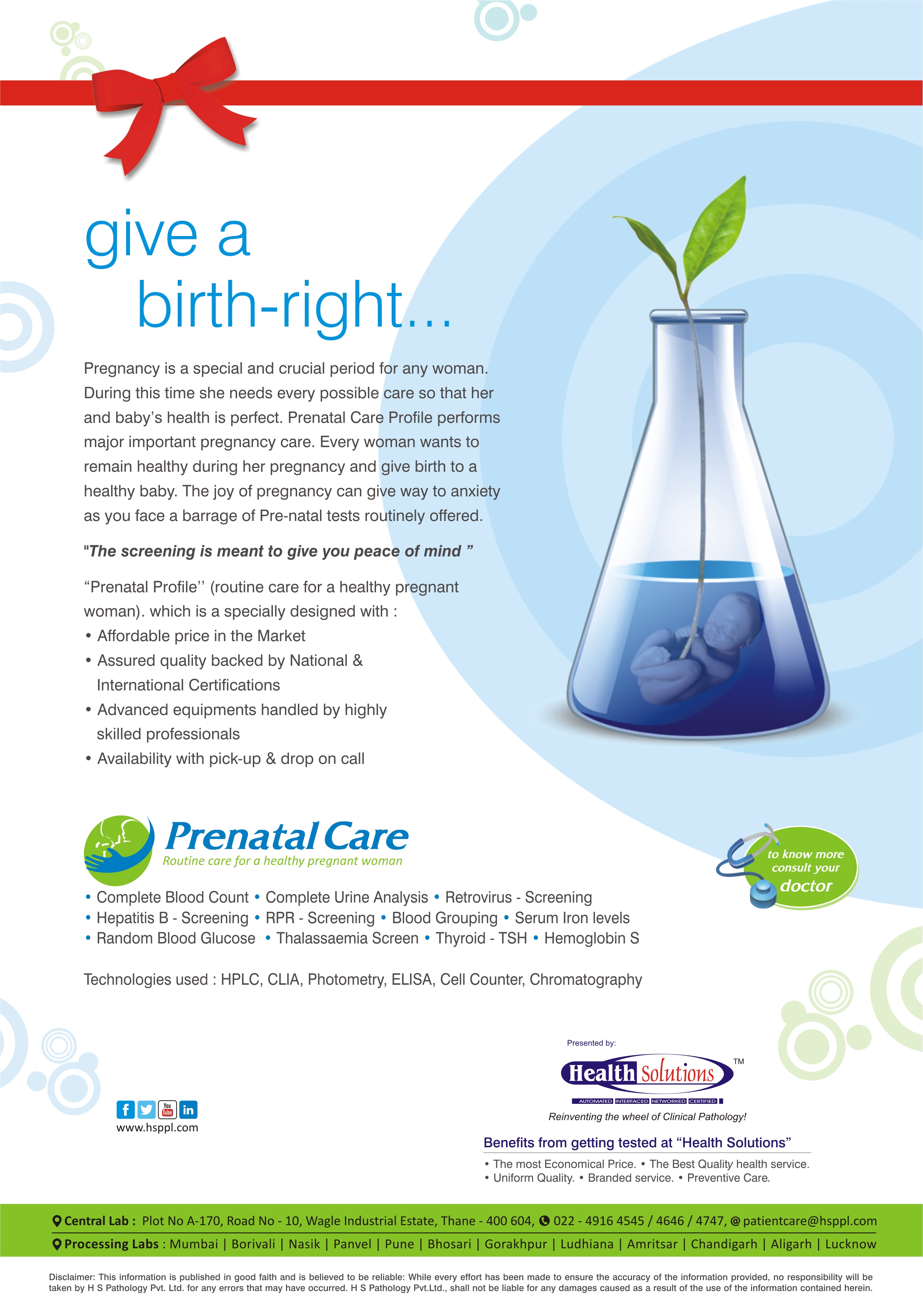


A simple blood test that can help save lives.
When liver get invasion by various pathogenic factor agent, it will cause liver damage and inflammatory response. At the same time, liver's immune system get activated and try to repair the tissue. Hepatic fibrosis means when the tissue repair process is excessive and out of control, a pathological process of liver structure and function he liver to abnormal status, which is caused by excessive proliferation and abnormal sediment of extracellular matrix. The mild symptom is called hepatic fibrosis; the serious symptom is called cirrhosis, which is caused by liver lobular structure reconstruction, false liver lobules and nodules.
HA (hyaluronic acid) : a matrix component, can be more accurate and sensitive to reflect the status of fibrosis and damaged condition of liver cells. Some reports show the HA level is even better that Liver biopsy as it is sensitive indicator for hepatic fibrosis and cirrhosis.
HA level elevates a little in the acute and chronic persistent hepatitis patients' serum, significantly in chronic active hepatitis patient serum, extremely in liver cirrhosis patients' serum.
LN (laminim protein): as the special non -collagen structure protein in the basement membrane, LN is positively correlated with activity of hepatic fibrosis and high pressure of portal vien, in addition, when the LN level elevate, the esophageal varices in Cirrhosis patient show more visible.
PIIIP N -P (type Ill collagen N terminal peptide): reflect intrahepatic synthesis of (type II collagen, serum concentration and hepatic fibrosis level is consistent.
C IV (type IV collagen) : as the main component of basement membrane, the level can reflect the turnover rate of basement collagen Elevated C IV concentration, which can reflect liver fiber process sensitively, is one of the main marker of Hepatic fibrosis in early stage. To reflect the degree of hepatic fibrosis. With course of disease developing : CPH, CAH, cirrhosis, liver cancer, C IV concentration in serum increase gradually;
C IV level also elevate in severe hepatitis and alcoholic hepatitis. It's a important indicator for medical treatment and prognosis observation. C IV level in serum is consistent with liver's histological change completely.
CG (Cholyglycine) : CG is synthesized in the liver cells, discharging into cholecyst for storage through bile duct. Then it goes into the small intestine along with bile when gallbladder contraction after eating, participating in fat digestion and absorption. 95% of the bileacid, which is repuptaken to the blood by the small intestinal mucosa, will be transported to the liver via the portal vein and abosrted by liver cells. When the liver cell damage, the bile sit up to elevate CG content to serum.

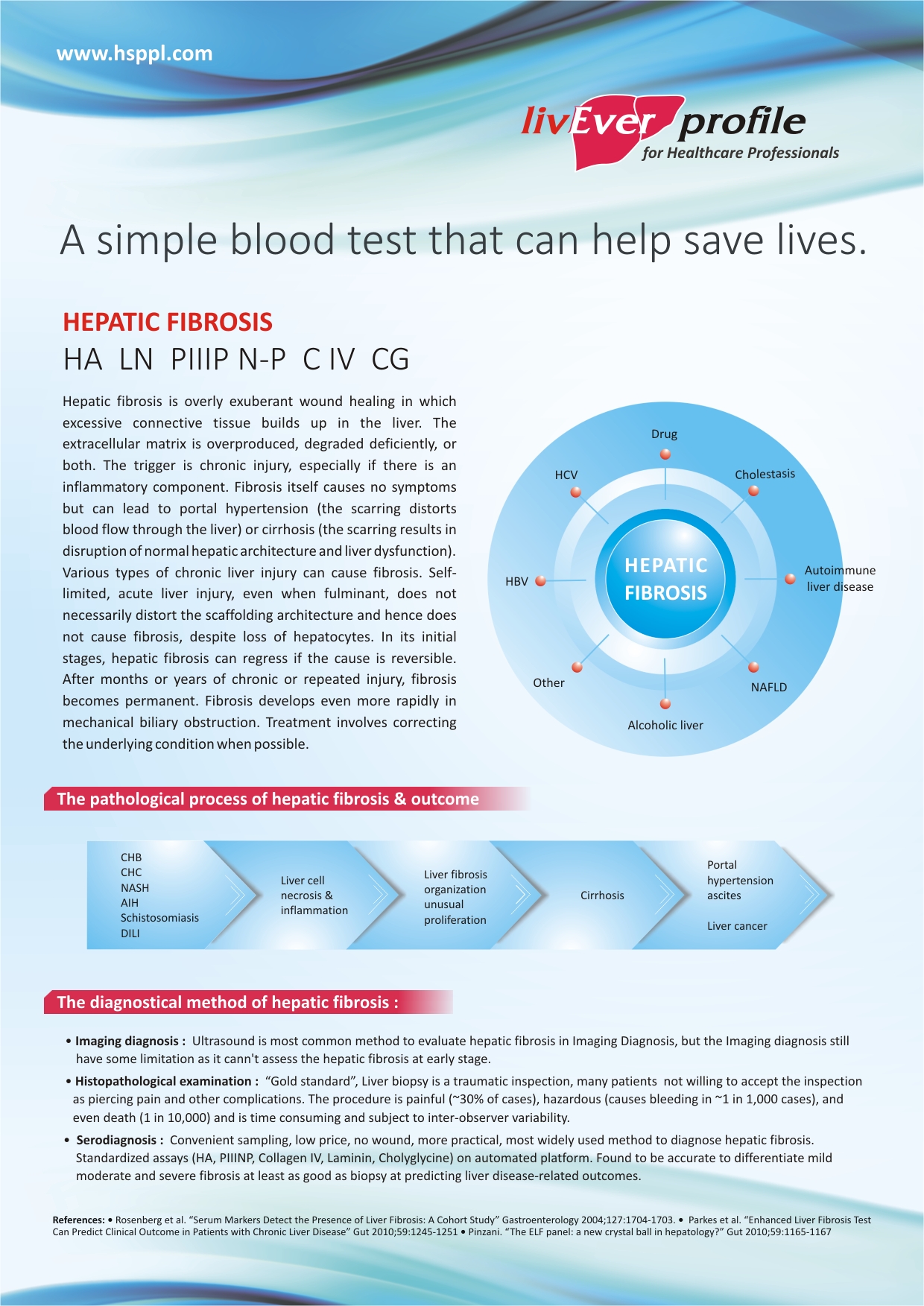
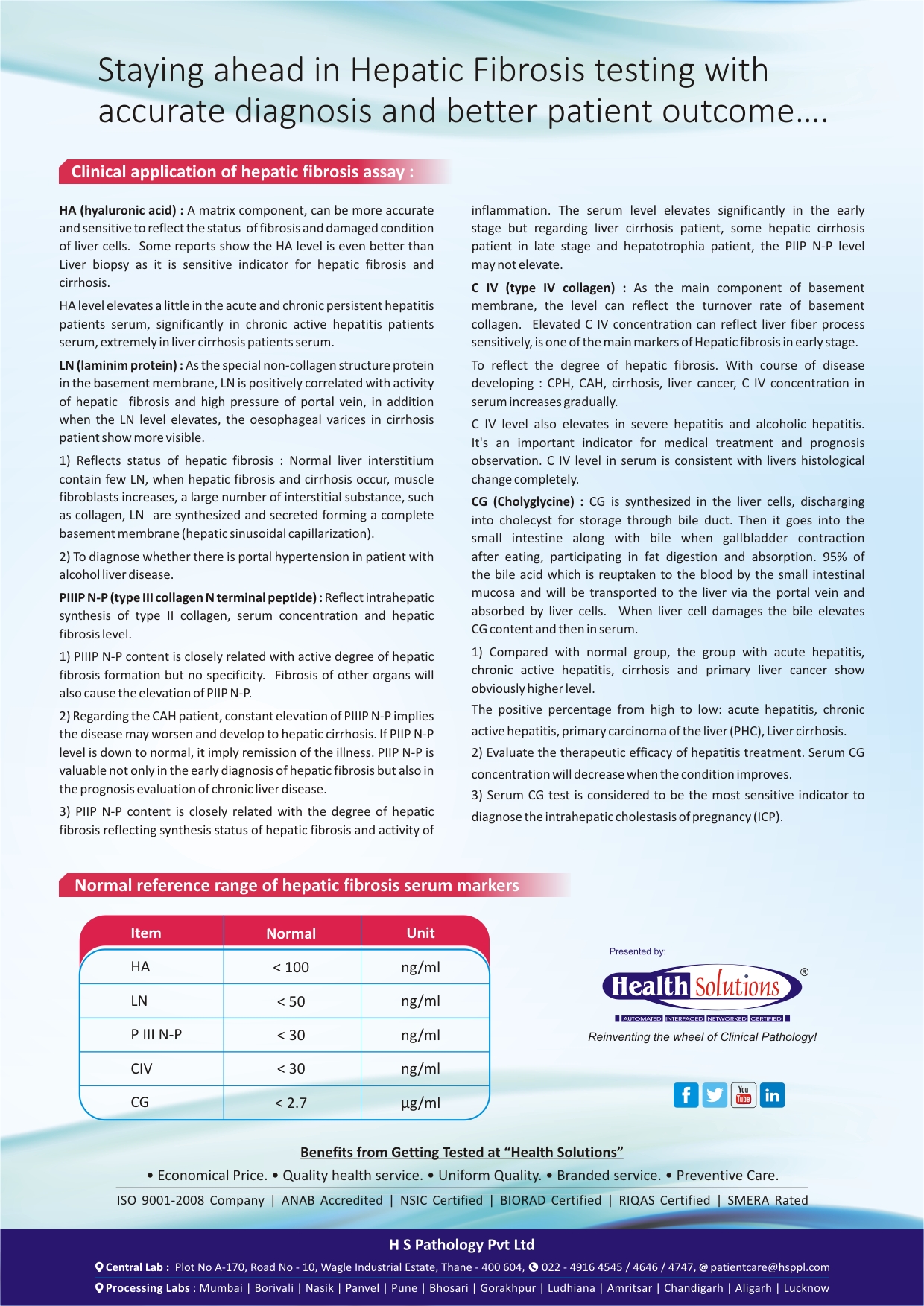

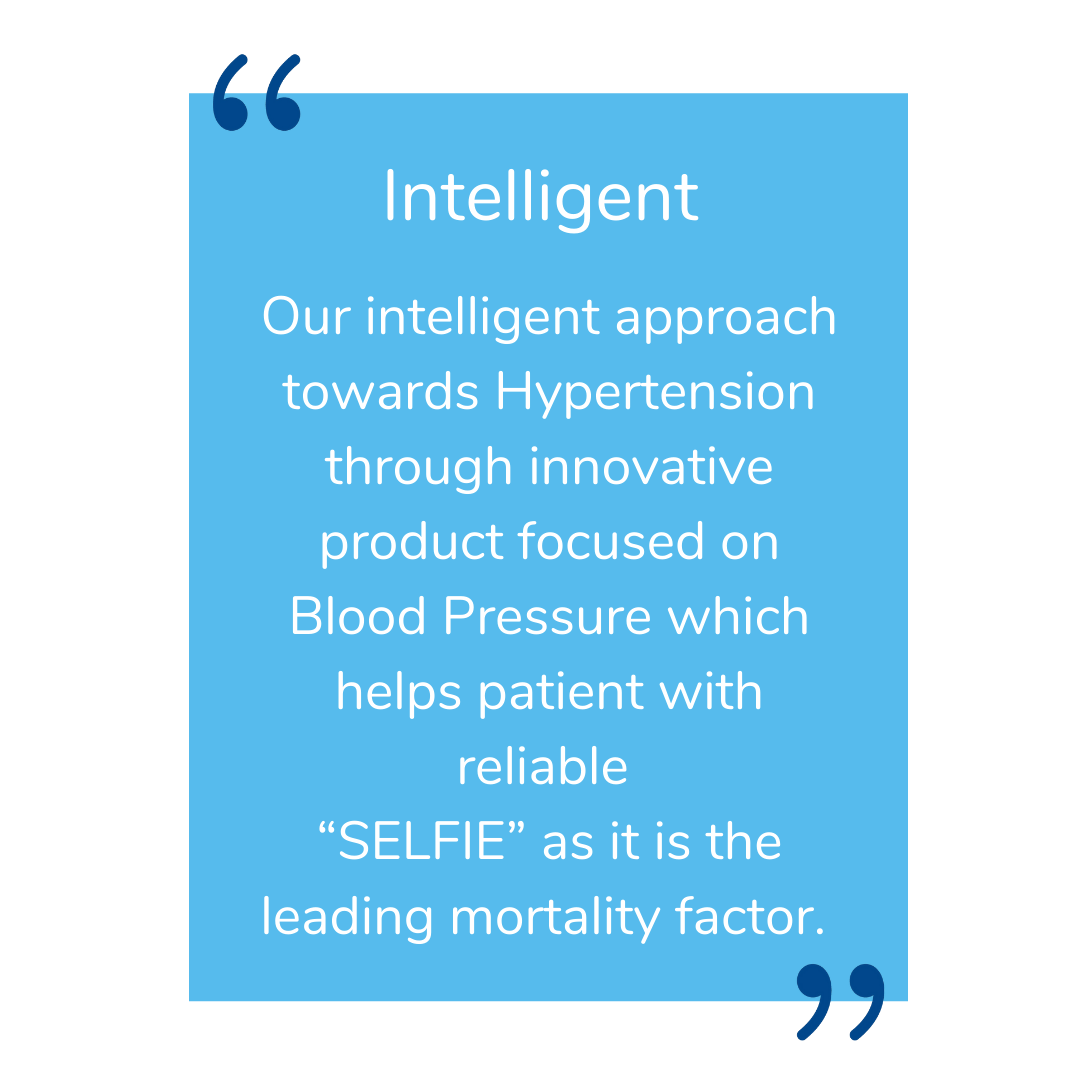
High blood pressure (BP) is a major public health problem in India and its prevalence is rapidly increasing among both urban and rural populations. In fact, hypertension is the most prevalent chronic disease in India.
About 33% urban and 25% rural Indians are hypertensive. Of these, 25% rural and 42% urban Indians are aware of their hypertensive status. Only 25% rural and 38% of urban Indians are being treated for hypertension. One-tenth of rural and one-fifth of urban Indian hypertensive population have their BP under control.
Test your hypertension Keep life safe in your hands.
Blood pressure
Normal blood pressure is vital to life: without the pressure that forces our blood to flow around the circulatory system, no oxygen or nutrients would be delivered through our arteries to the tissues and organs. Blood pressure can be unhealthily high, but it can also be too low. Without a normal baseline, white blood cells - which are part of our immune system -would not get distributed around our bodies.
We can have high blood pressure (hypertension) for years without any symptoms. Even without symptoms. Even without symptoms, damage to blood vessels and heart continues and can be detected.Uncontrolled high blood pressure increases risk of serious health problems, including heart attack and stroke.
High blood pressure generally develops over many years, and it affects nearly everyone eventually. Fortunately, high blood pressure can be easily detected.
Endocrine Society practice guidnes for the diagnosis and Treatment of primary Aldosteronism have Highlighted the importance of ALDOSTERONE and REFIINI testing. Aldosterone and Renin tests should usually be requested by clinicians together when a patient shows high blood pressure and low potassium. Even if potassium is normal, testing may be done if typical medications do not control the high blood pressure or if hypertension develops at an early age.
Blood tests and high blood pressure : FAST, SIMPLE & ACCURATE
along with conventional tests, there are some more new and advanced tests, which have been extensively studied during the recent years as useful predictors of risk of developing Hypertension.
Advanced test solutions powered by Health Solutions
Direct Renin & Aldosterone may be useful to address the pharmacological treatment of the hypertensive patient monitor effectiveness of the therapy with Renin inhibitors (Aliskiren by Novartis) assess the risk of cardiovascular events diagnose Primary Aldosteronism.
LEVELS OF RENIN ARE FUNCTION OF THE NUMBER OF CARDIOVASCULAR EVENTS
Direct Renin assay is a valid alternative to PRA as it reflects the RAS effects Aldosterone/Renin ratio (ARR) calculated with the Direct Renin assay gives levels statistically correlated to those o h PRA Average levels for ARR calculated with the Direct Renin assay stay in the normal limits shown by the Endocrine Society Guideline and obtained with different direct Renin techniques. Similar levels obtained for ARR regardless from posture and ACEI / ARB treatment suggest the possibility of lowering the degree of attention to those conditions when the ARR test is performed
The renin-angiotensin-aldosterone system (RAAS) is one of the main regulators of blood pressure and of sodium/water metabolism and its alterations are relevant in the pathophysiology of numerous cardiovascular diseases. Increasing published evidence shows that the pharmacological antagonism of RAAS markedly reduces the major cardiovascular events and the progression of renal insufficiency.
The evaluation of RAAS activity is crucial for diagnostic and therapeutic purposes. This evaluation turned out to be difficult because the commonly used method to assess the effects of RAAS, i.e. the measurent of plasma renin activity (PRA), is a complex procedure With poor interlaboratory reproducibility.
This drawback has led to limited use of PRA determination, depriving the clinician of a powerful tool for diagnosing relatively frequent forms of hypertension and for selecting the most effective therapeutic regimen.
Revolution in hypertension testing.
At Health Solutions Direct Renin assay is performed on automated platform, which exploits the high specificity of monoclonal antibodies to detect the renin molecule, offers the possibility of evaluating RAAS activity which is methodologically simpler, faster and more reproducible than PRA.
Staying ahead with accurate diagnosis and bet patient outcome.

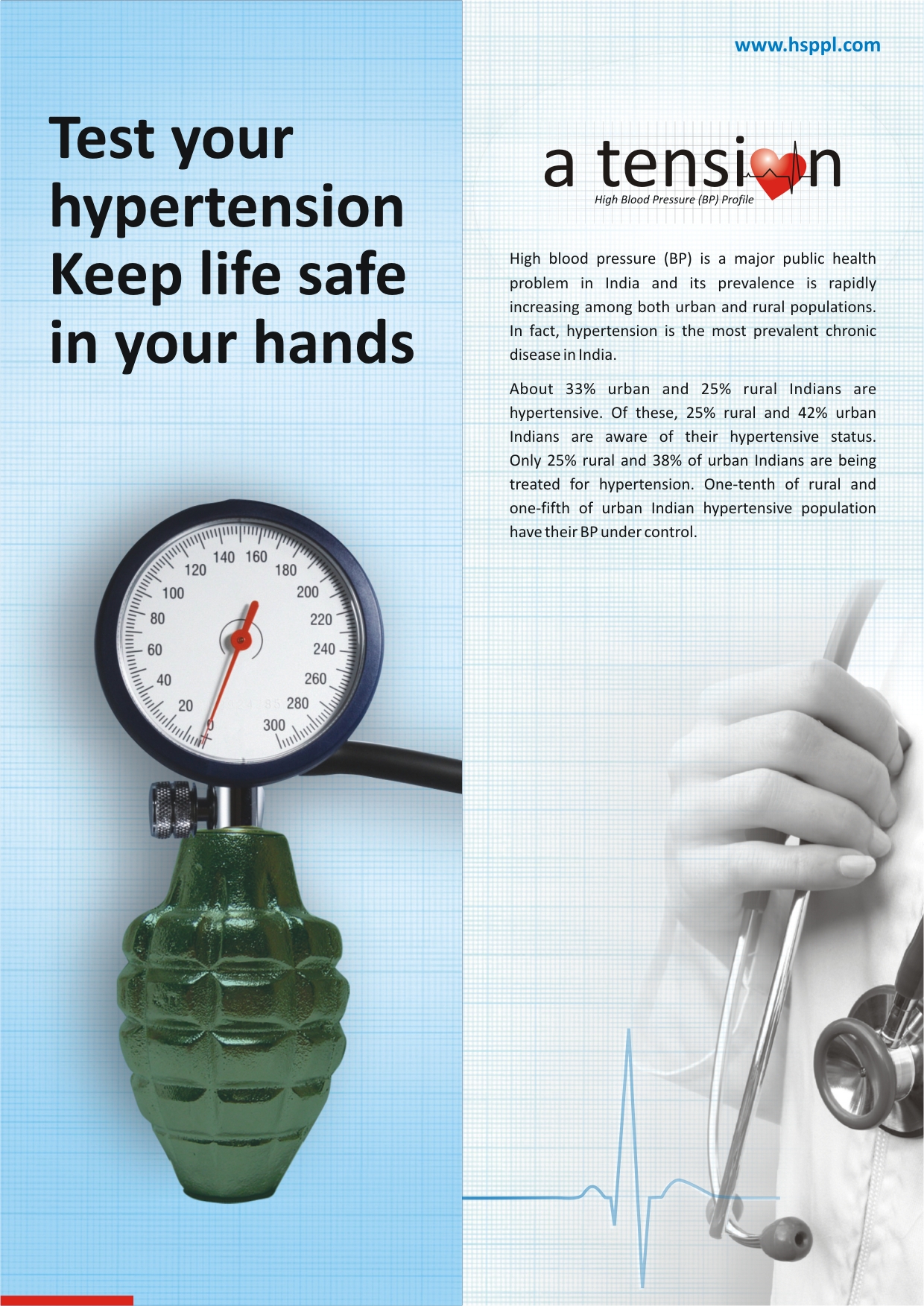
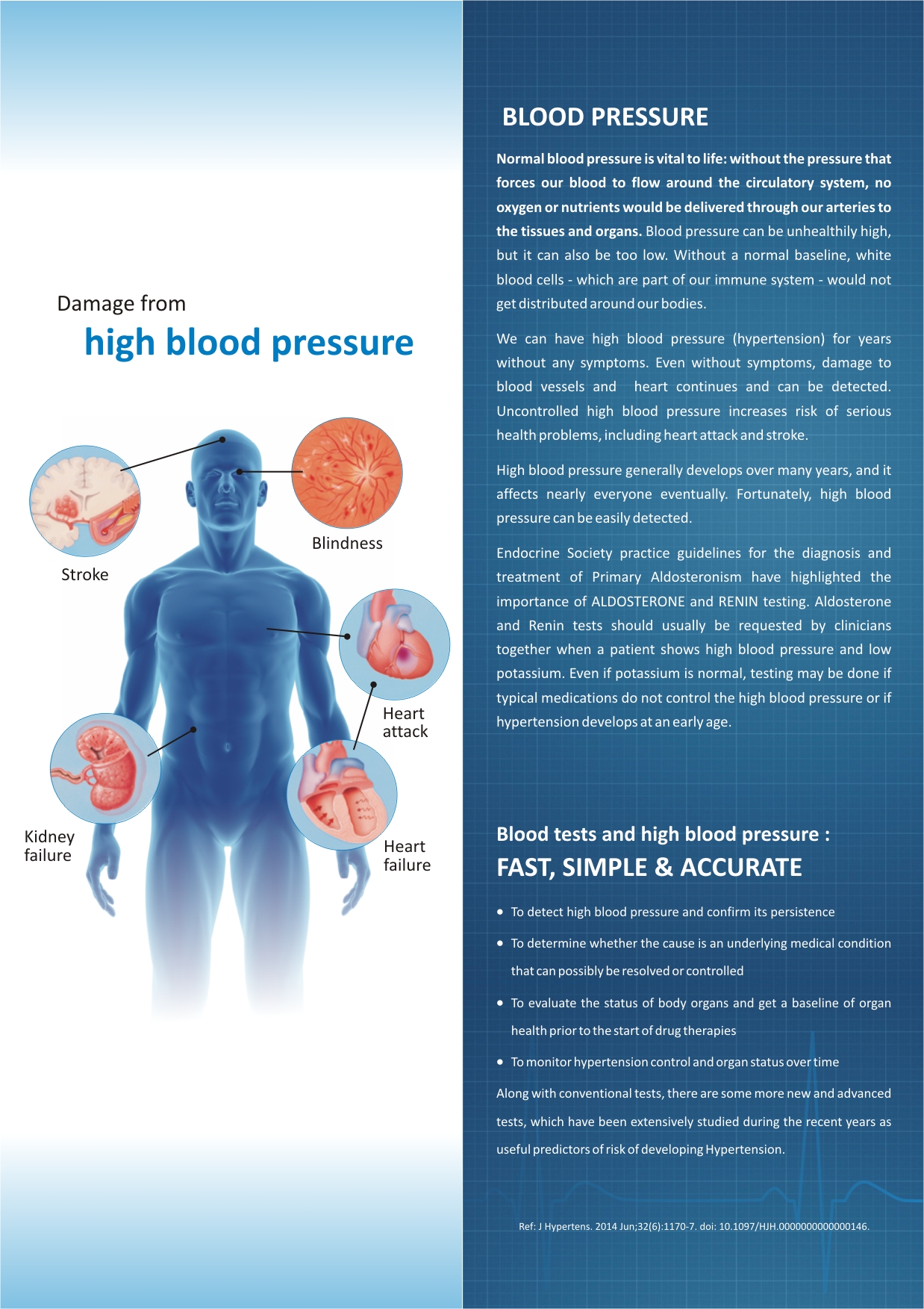
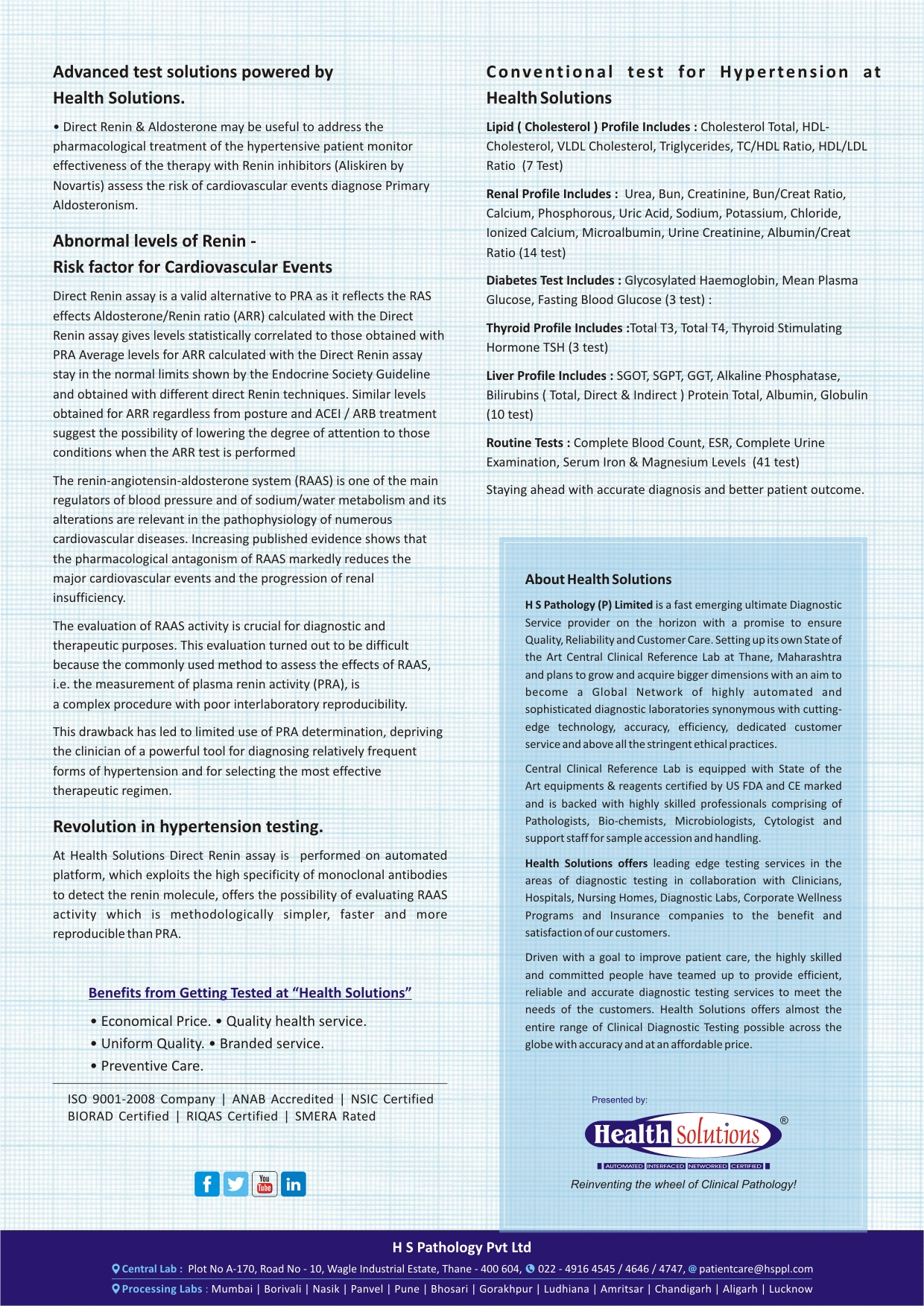

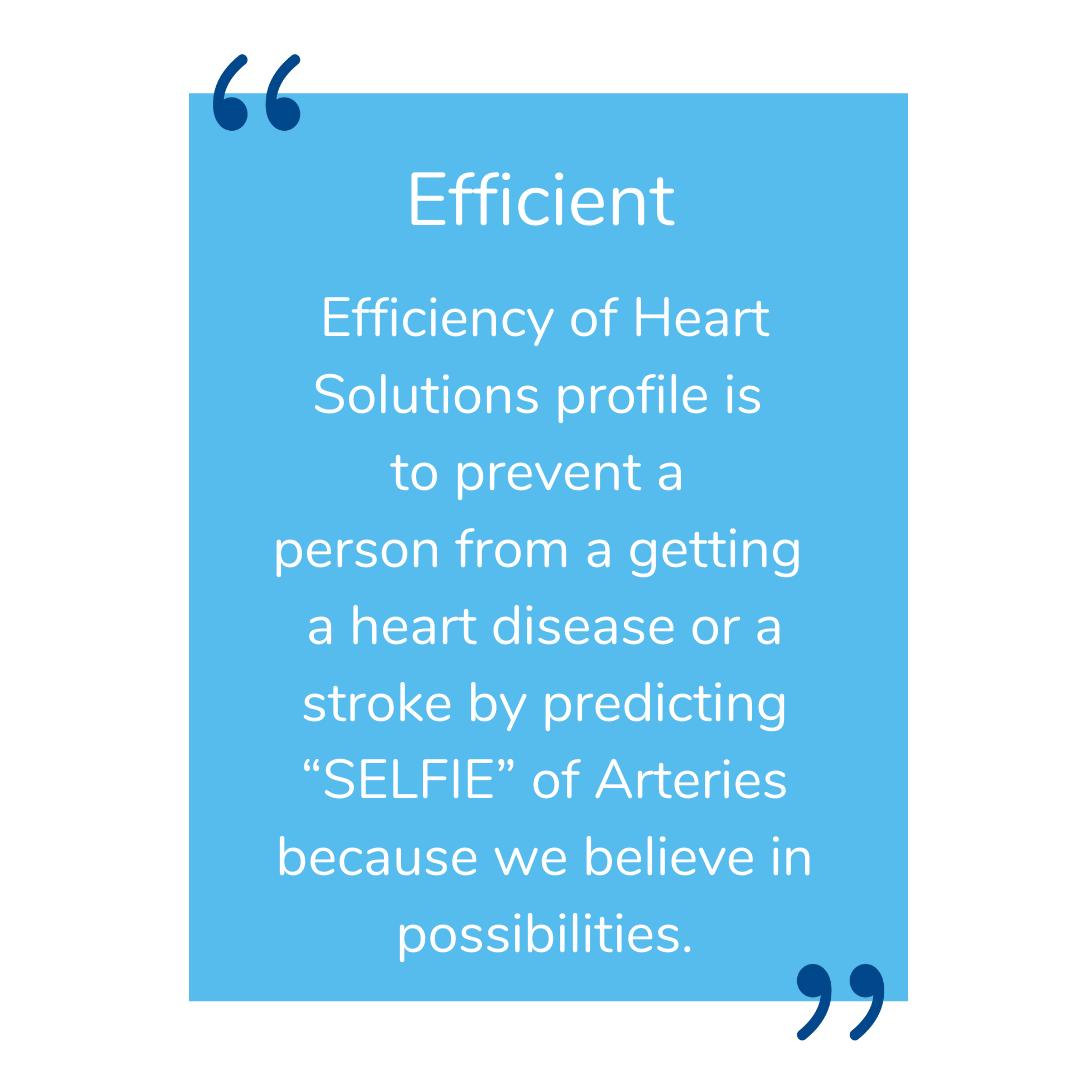
In most adults, cholesterol (Lipids) causes a fatty deposit called plaque to build up in the walls of the arteries. When these walls become inflamed, our body produces an enzyme called Lp-PLA2. Scientists used to think that narrowing of arteries was the main cause of heart attacks and strokes. However, recent studies show that in over 68% of heart attacks the arteries are not narrow. Instead, the inside wall of the inflamed artery becomes weakened and ruptures, letting plaque into the bloodstream, where the plaque can cause a clot.
Your arteries do not hurt when they are inflamed and there are no early symptoms of cardiovascular disease. You may have problems without knowing it.
Lp-PLA2 test is a simple blood test that measures the amount of an enzyme in your blood called Lp-PLA2. When your arteries are inflamed, a fatty deposit called plaque builds up in the walls of the artery. If the amount of Lp-PLA2 in your blood is high, this may indicate that the plaque might rupture through the inside wall of the artery into your bloodstream, where it may cause a clot that could result in a heart attack or stroke. Your body will create a thick fibrous cap to contain the lipid pool and stabilize the plaque. As the lipid pool continues to grow, the fibrous cap thins and eventually ruptures resulting in a clot (thrombus). Individuals who have an elevated Lp-PLA2 Test score and one or more risk factors have more than twice the risk of having a heart attack. If the Lp-PLA2 Test is elevated and they have high blood pressure, their risk for stroke increases more than 6 times. In addition, almost 95% of people with risk factors for heart attack or stroke who had a normal or low Lp-PLA2 Test result did not have a heart attack or stroke within 2 years.
People with the highest Lp-PLA2 levels were 89% more likely to have heart attacks, angina, or bypass/angioplasty procedures than were people with the lowest Lp-PLA2 levels. Risk quickly rose with rising Lp-PLA2 levels.
There are a number of factors that have been shown to help predict that someone is at increased risk of a heart attack or stroke. These factors include:

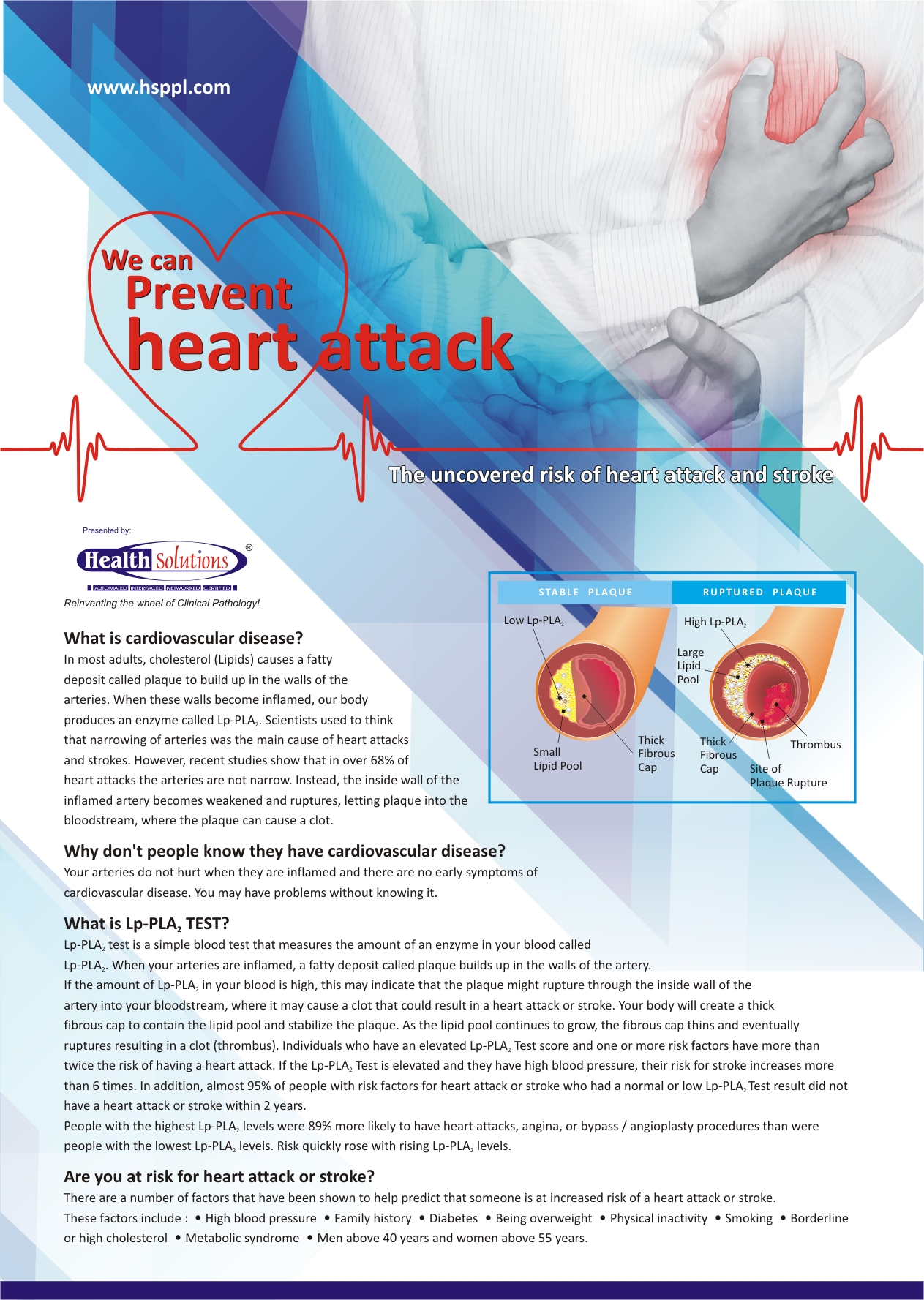

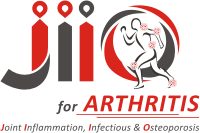
There are more than 100 types of arthritis – or musculoskeletal conditions – which are spilt into three classifications: Inflammatory arthritis – such as rheumatoid arthritis, ankylosing spondylitis, gout. Non-inflammatory arthritis – such as osteoarthritis, scoliosis, torn ligaments.


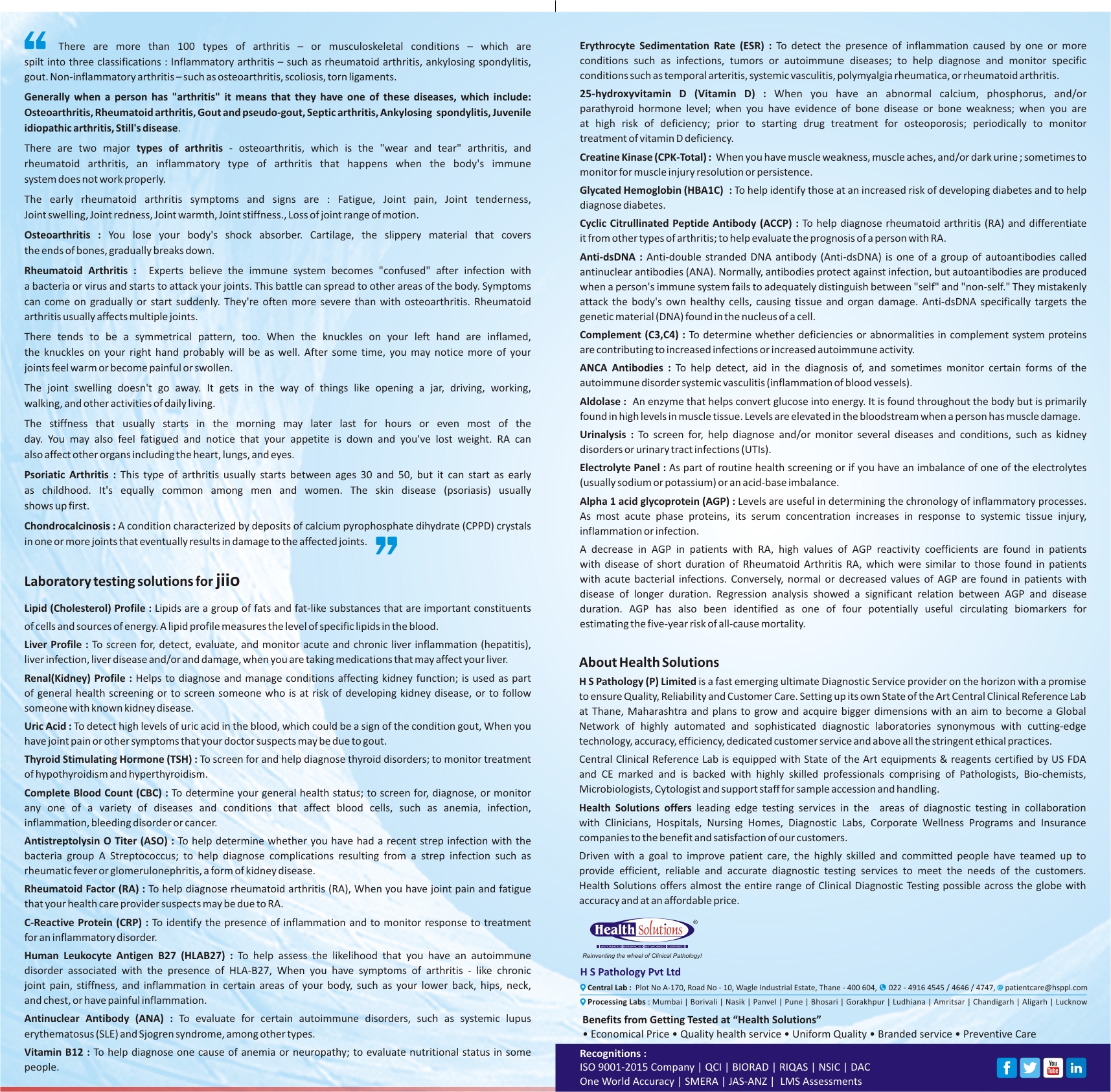

Allergy can be described as a malfunction of human immune system casing as adverse reaction against normally harmless substances in our natural environment. In this context such substances are generally referred to as "allergens". The reaction creates an inflammation which, in turn, can lead to variety of symptoms such as hay fever, eczema, asthma and other conditions popularly referred to as allergies.
Since allergy is our body's response to any foreign element in our system there could be thousands of allergens which could cause an allergic reaction. Hence the approach should involve multiple levels
The one stop solution for all your diagnostic neets


